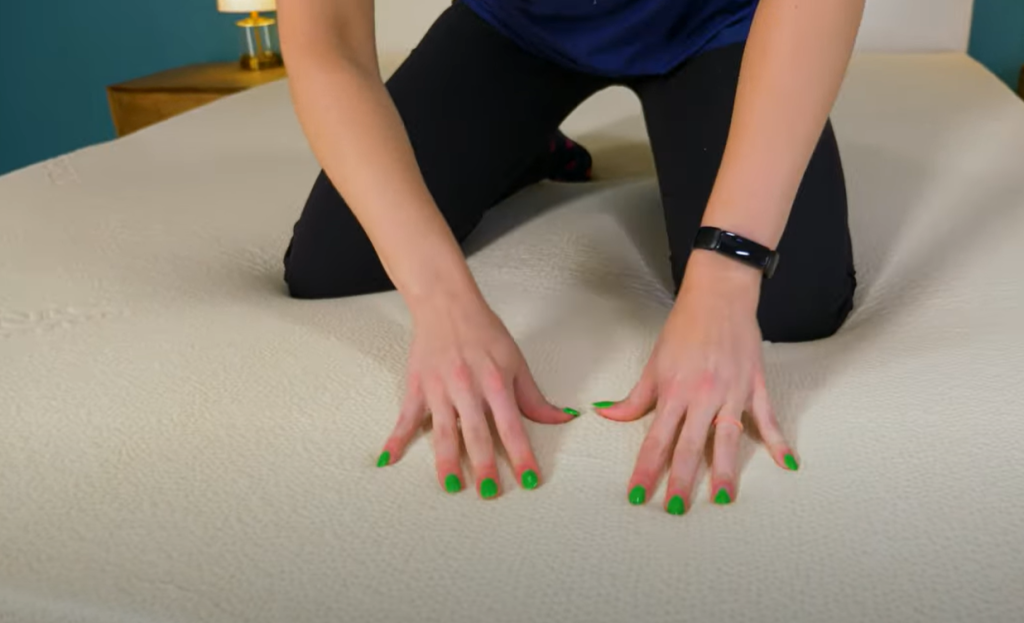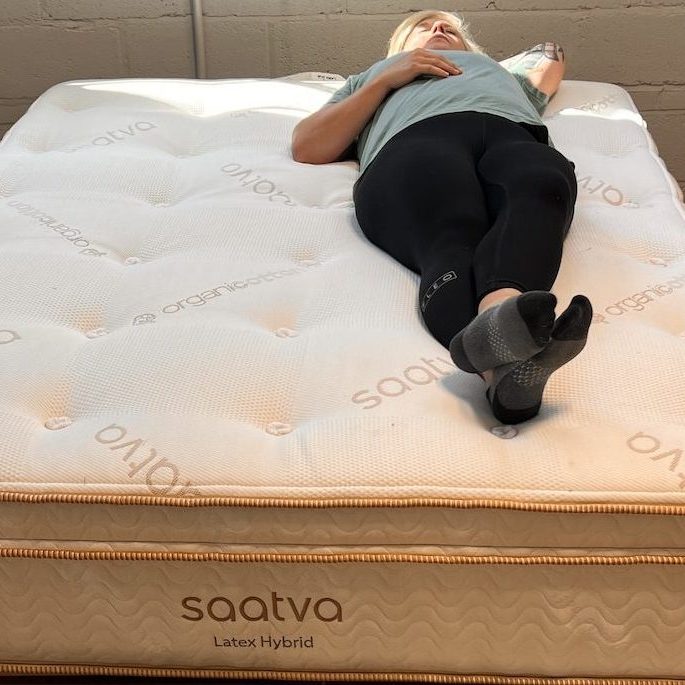If you’ve been looking at latex mattresses or bedding accessories you’ve probably come across the terms Dunlop and Talalay, wondering what they mean. Dunlop and Talalay refer to two different processes for manufacturing latex, each with its own pros and cons that can impact the performance and feel of a latex product.
If you want to know more about what each process offers, we’re here to help. Our Dunlop vs. Talalay latex guide will give you a thorough look at each manufacturing style.
What Is Latex Foam?
Latex foam is made from a milky substance from the Hevea-brasiliensis rubber tree. The substance is removed from the tree and prepared into a foamy and airy substance. The process gives latex a soft texture. Some latex can be 100 percent natural, chemical-free, and eco-friendly. However, many manufacturers also produce synthetic latex or a blended version that contains both synthetic and natural components. The most popular characteristics of latex are that it is cooler, bouncy, and highly durable.
There are two methods of producing latex foam: Talalay and Dunlop. Creating both types is the same up to a certain point. Everything starts by extracting the milky rubber tree substance and mixing it with a bit of water. The next is to pour the liquid into a mold, which can be done in two ways. Filling the mold only halfway produces Talalay latex, and filling it to the top makes Dunlop latex.

What Is Dunlop Latex?
Dunlop latex is more affordable than Talalay as it’s simpler to produce. The Dunlop production method began in January 1929 and hasn’t changed much since then. Dunlop is the first method invented for making latex foam, so it’s also more widely known. The material is durable and can experience a lot of use before showing signs of wear and tear.
How is it made?
Dunlop latex is made by adding liquid latex into a press machine to distribute it into a mold. Once it’s dispersed and shut into the press, the hot steam cooks it into a solid, which is known as vulcanization. The latex is then removed from the mold and washed to get rid of any dirt and debris. Lastly, it’s baked once again to remove any excess moisture. The result is a dense, firm latex foam slightly softer at the top. This makes Dunlop latex excellent for support layers, although many mattresses have it in comfort layers as well.
What Is Talalay Latex?
Talalay is a newer method of developing latex. Talalay latex is designed to be softer than Dunlop, often cradling the sleeper better for enhanced pressure relief. For this reason, Talalay latex is usually placed in the top comfort layers of a mattress. Talalay tends to have a more uniform feel to it compared to Dunlop. However, Talalay latex is also aerated, which means it is less dense and firm. Because of the difficulty to make a completely natural Talalay latex foam, the material will often contain synthetic ingredients like polyurethane.
How is it made?
Making Talalay latex involves pouring the liquid latex into a mold only halfway through. The partially-filled mold is then air-tight sealed, allowing the liquid to expand and fill the rest of the mold. Next, the mold is frozen to preserve it before the makers heat it through a process known as vulcanization. After vulcanization, the latex is then cleaned and dried.
Pros and Cons of Dunlop Latex
Pros and Cons of Talalay Latex
Main Differences Between Dunlop and Talalay Latex
Talalay and Dunlop latex foams are manufactured differently, influencing important factors you will need to consider as a potential buyer.
Firmness
At first touch, you can notice that Talalay latex is softer than Dunlop. Dunlop is firmer and often used for support layers in latex mattresses, whereas Talalay is used in comfort layers. Nonetheless, both versions can be engineered to various firmness levels, giving shoppers a variety of options.
Breathability
Talalay takes the win here as it’s more breathable than Dunlop. Dunlop is denser than Talalay, so it won’t provide as much airflow. As a result, Talalay sleeps cooler, making it a better option for hot sleepers.
Durability
Dunlop is often considered more durable than Talalay because it’s denser. However, both types offer substantial durability compared to memory foam and other mattress materials. Durability is significant because it can impact how long the product will perform at optimal levels. If you want something that lasts as long as possible, you might consider Dunlop latex foams.
Price
Dunlop is less expensive to make because the manufacturing process isn’t as long and doesn’t take as much energy. This is best reflected in the final price of Dunlop and Talalay latex mattresses, although it sometimes depends on other materials and technologies used to produce a certain bed. Therefore, you may generally find that Dunlop latex beds are cheaper compared to Talalay.
Sustainability
Latex is considered more sustainable than memory foam and other alternatives, regardless of how it’s produced. This is because the material comes from a natural and sustainable source, so the environmental cost is lower. However, Dunlop is the more eco-friendly of the two because the manufacturing process is less energy-intensive, making it slightly more sustainable than Talalay.
Which One Should I Choose?
Ultimately you will have to see how both types compare and determine which features are more important to you. Regardless of which production method you opt for, you can expect more buoyancy, breathability, durability, and sustainability with latex products.
Dunlop latex isn’t as consistent as Talalay but is denser and more supportive. On the other hand, Talalay is softer and cooler but not as durable as Dunlop.
Talalay latex is also more expensive, but Dunlop is considered more cost-effective as it’s more durable and therefore, should last longer. Dunlop latex is better for the environment since producing it doesn’t take as much time and energy as it does to produce Talalay latex.
If you want the best latex mattress, be sure to check out our best latex mattresses here.

Who I Recommend Dunlop For?
- Sleepers looking for support – Dunlop’s density makes it more supportive than Talalay.
- Eco-conscious shoppers – Dunlop doesn’t take as much time and energy to produce, and it can be produced with all-natural materials.
- Budget shoppers – Although latex is typically more expensive than other materials, those made with Dunlop are going to be cheaper than the ones constructed with Talalay.
Who I Recommend Talalay For?
- Pressure relief seekers – Talalay offers deeper contouring, making it a great choice for those who want to relieve pressure.
- Hot sleepers – Talalay latex is less dense, making it the cooler option for sleepers.
- Those who prefer a softer feel – Talalay is softer than Dunlop, providing a cozy mattress for those who like softer beds.
Frequently Asked Questions
Which is softer, Talalay or Dunlop?
Talalay latex is softer because of the amount of aeration that makes it less dense, which is why it’s often found in comfort layers. So, if you’re looking for the softer option of the two, you should consider Talalay. However, both types can be produced at different firmness levels, so you can find a range of soft, medium, and firm latex mattresses.
Is natural latex the same as Talalay latex?
Talalay latex is rarely all-natural as it often contains synthetic materials. However, the percentage of synthetic ingredients is within the numbers allowed by the Global Organic Latex Standard Certification. Besides that, Talalay latex is made from the same natural rubber tree as Dunlop latex. However, some manufacturers produce synthetic latex, so if you want more natural options, look for brands that advertise natural latex specifically.
Does Dunlop latex sleep hot?
Generally, latex beds are cooler than memory foam, but Dunlop will likely sleep warmer than Talalay because of its higher density. Many brands find other ways to help sleepers stay extra-cool on their latex beds, including using breathable fabrics in the mattress covers to increase the cooling effect.
To Wrap It Up
When it comes to buying a latex mattress, there are several factors to consider, including if you prefer one made with Dunlop latex or Talalay latex. While there are some differences, such as the density and the energy used in the manufacturing process, both make durable, comfortable beds that should serve you well for a long time.
The Advisor Says
Don’t be turned off by the initial price of latex beds. Although they typically cost more, they also tend to hold up better and last longer than other types of mattresses.

Olivera Jancikin
Content Writer
About Author
Olivera is a content writer for Sleep Advisor and is enthusiastic about sleep. She firmly believes in the benefits of daytime naps on top of getting a full 8-hour sleep at night.
Combination Sleeper
